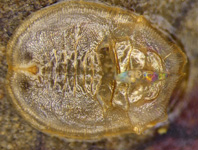Abstract
A new species, Kermicus huizhouensis Wu & Huang sp. n. (Hemiptera: Coccomorpha: Pseudococcidae), is described and illustrated based on the adult female, second instar female and first-instar nymph. It was collected at Qianfeng village, Huiyang District, Huizhou City, Guangdong Province, P. R. China, inside the stem of bamboo Bambusa rigida (Poaceae) and attended by the ant Tetraponera binghami (Forel) (Hymenoptera: Formicidae). It differs from K. wroughtoni Newstead, 1897 by the adult female lacking multilocular disc pores in the marginal region of the venter, and both the adult female and first-instar nymph having the anal ring bearing 16–20 setae. Keys to genera of legless mealybugs on bamboo based on adult females, and the immature stages of Kermicus, are provided.
References
Avasthi, R.K. & Shafee, S.A. (1987) Indian Pseudococcidae (Homoptera: Coccoidea). Indian Journal of Systematic Entomology, 4 (1), 1–54.
Ben-Dov, Y. (2007) Wapoacoccus dougwilliamsi n. gen., n. sp. of leg-less mealybug from Australia (Hemiptera. Coccoidea, Pseudococcidae). Bulletin de la Société entomologique de France, 112 (4), 477–480.
Borchsenius, N.S. (1950) [Mealybugs and Scale Insects of USSR (Coccoidea)]. Akademii Nauk SSSR, Zoological Institute, Moscow, 32, 1–250.
Cockerell, T.D.A. (1899) Tables for the determination of the genera of Coccidae. The Canadian Entomologist, 31, 273–279.
https://doi.org/10.4039/Ent31273-10
Fernald, M.E. (1903) A catalogue of the Coccidae of the world. Bulletin of the Hatch Experiment Station of the Massachusetts of Agricultural College, 88, 1–360.
García Morales, M., Denno, B.D., Miller, D.R., Miller, G.L., Ben-Dov, Y., & Hardy, N.B. (2016) ScaleNet: a literature-based model of scale insect biology and systematics. Database. Available from: http://scalenet.info (accessed 30 June 2020)
https://doi.org/10.1093/database/bav118
Gavrilov-Zimin, I. (2016) Cytogenetic and taxonomic studies of some legless mealybugs (Homoptera: Coccinea: Pseudococcidae). Comparative cytogenetics, 10(4): 587–601.
https:// doi: 10.3897/compcytogen.v10i4.10503
Gavrilov-Zimin, I. (2017) A remarkable example of symbiosis between an animal and a fungus in a new species of legless mealybug (Insecta: Pseudococcidae). Journal of Natural History, 51(37-38),2211–2224.
https:// doi: 10.1080/00222933.2017.1365180
Hendricks, H. & Kosztarab, M.P. (1999) Revision of the Tribe Serrolecaniini (Homoptera: Pseudococcidae). de Gruyter, Berlin and New York, xiv + 213 pp.
Newstead, R. (1897) Observations on Coccidae (No. 16). Entomologist's Monthly Magazine, 33, 165–171.
Tang, F.T. (1984) Discovery of a new species of Idiococcus and discussion on the systematic status of this genus. Verhandlungen Des Zehnten Internationalen Symposiums Uber Entomofaunistik Mitteleuropas (SIEEC), 10, 393–399.
Varshney, R.K. (1985) A review of Indian coccoids (Homoptera: Coccoidea). Oriental Insects, 19, 1–101.
https://doi.org/10.1080/00305316.1985.10433701
Williams, D.J. (2004) Mealybugs of southern Asia. The Natural History Museum. Southdene SDN. BHD., Kuala Lumpur, 896 pp.
Wu, S.A. (2005) Morphological descriptions on immature stages of Porisaccus jiuhuaensis (Wu) and the origin of bag-like appendage (Homoptera: Pseudococcidae). Journal of Beijing Forestry University, 27 (6), 89–90.
Wu, S.A. & Lu, Y. (2012) Notes on the genera and species in the mealybug tribe Serrolecaniini Shinji (Hemiptera: Coccoidea: Pseudococcidae) from China with description of a new species. Zootaxa, 3251 (1), 30–46.
https://doi.org/10.11646/zootaxa.3251.1.2


